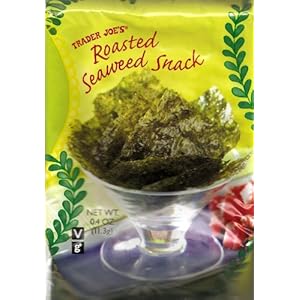There are few ways around it: bread usually comes in some kind, most often a plastic bag.
You'd be surprised how easy and fun it is to bake your own bread. Though it's a time-consuming project--maybe 4 hours?--it's not labor-intensive, and the recipe below makes so much bread that most households will only have to bake bread once a month. (I slice all of it, freeze most of it and keep half a loaf in the refrigerator to eat.)
Baking your own bread is healthy, saves money, and saves plastic bags. You can choose your own "extras" to make your loaves as healthful and delicious as you'd like. Our most recent batch was sprinkled with crunchy flax seeds.
Best of all, homemade bread is insanely tasty.
Tassajara Yeasted Bread (from The Tassajara Bread Book)Part I
3 cups lukewarm water (85-105 F)
1 1/2 Tbsp. dry yeast (2 packets)--for faster rising and lighter bread, use and additional packet of yeast (about 3/4 Tbsp.)
1/4 cup sweetening (honey, molasses, or brown sugar)
1 cup dry milk (optional--though I think it's essential)
4 cups whole wheat flour (substitute 1 or more cups unbleached white flour to make the dough more cohesive, if desired)
Part II
4 tsp. salt
3 cups additional whole wheat flour
1 cup whole wheat flour for kneading
Dissolve the yeast in water.
Stir in the sweetening and dry milk.
Stir in the 4 cups of whole wheat flour to form a thick batter.
Beat well with a spoon (100 strokes).
Let rise 45 minutes.
Fold in salt and oil.
Fold in an additional 3 cups of flour til the dough comes away from the sides of the bowl.
Knead on a floured board, using more flour (about 1 cup) as needed to keep the dough from sticking to the board, about 8-10 minutes, until the dough is smooth.
Put into large, lightly-oiled bowl, and allow to rise, covered, for 50-60 minutes.
Punch down.
Let rise 40-50 minutes until doubled in size.
Shape into loaves and place in pans.
Let rise 20-25 minutes.
Brush tops with Egg Wash (see below).
Make in 350F oven for 1 hour, or til golden brown.
Remove from pans and let cool--or eat right away.
Variations:
For the 3 cups of flour in the second part of the recipe, the following ingredients may be substituted: rye flour, rolled oats, cornmeal, millet meal or whole millet, wheat bran, wheat germ, rice flour, barley flour, soy flour. If cooked grains or cereals are added, additional wheat flour will be necessary to compensate (or the amount of water at the start can be reduced). Generally only one or two of these grains or flours are added in addition to the wheat flour. When more grains are used, the bread tends to lose the distinctiveness of its taste. The use of rice flour, wheat germ, wheat bran, and soy flour in particular will tend to make the bread heavier and denser, although this is also true of any of the flours besides wheat.
For Cinnamon-Raisin bread, fold in 2 Tbsp. cinnamon and 1 cup of raisins along with the salt and oil.
For nut or see bread, add a cup or more of any chopped or whole nuts or seeds of your choosing along with salt and oil. Slightly roasting the seeds or nuts accentuates their fragrant nutty qualities.
For Fruit Bread, add a cup or more of chopped, soaked, or cooked dried fruit: apricot, prune, peach, date, apple, etc. Add along with salt and oil.
Egg washBeat an egg with 2 Tbsp. cold water or milk. Brush on the top of the bread before baking. More water or milk can be used if you want the egg to cover more loaves.









